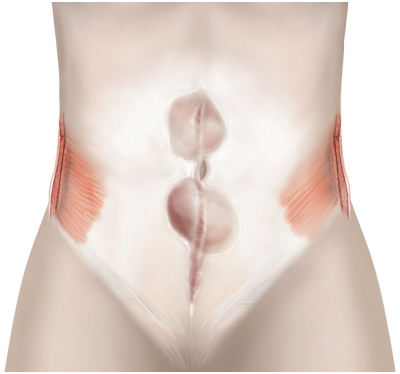What is an incisional hernia?
Any operation on your abdomen needs a cut that is closed with stitches. Sometimes your wound does not heal properly, resulting in the contents of your abdomen pushing through. This produces a lump called a hernia (see figure 1). A hernia can be dangerous because your intestines or other structures within your abdomen can get trapped and have their blood supply cut off (strangulated hernia).
What are the benefits of surgery?
You should no longer have the hernia. Surgery should prevent serious complications.
Are there any alternatives to surgery?
You can sometimes control the hernia with supportive clothing or simply leave it alone. It will not get better without surgery.
What does the operation involve?
Various anaesthetic techniques are possible. The operation usually takes about 90 minutes. Your surgeon will make a cut through your old scar. They will repair the weak tissue either with stitches only or using a synthetic mesh, which they will stitch to the muscles.
What complications can happen?
1. General complications
- Pain
- Infection of the surgical site (wound)
- Bleeding
- Unsightly scarring
- Blood clots
2. Specific complications
- Developing a lump under your wound
- Difficulty passing urine
- Skin necrosis
- Injury to structures that come from your abdomen and are within the hernia
- Injury to nerves
- Removing your umbilicus (belly button)
How soon will I recover?
You should be able to go home after one to four days.
Increase how much you walk around over the first few days.
Your doctor will tell you when you can return to work.
Regular exercise should help you to return to normal activities as soon as possible. Before you start exercising, ask the healthcare team or your GP for advice.
The hernia can come back.
Summary
An incisional hernia is a weakness in your abdominal wall which happens when previous wounds do not heal properly. If left untreated, an incisional hernia can cause serious complications.
Acknowledgements
Author: Prof Simon Parsons DM FRCS (Gen. Surg.) and Mr Jonathan Lund DM FRCS (Gen. Surg.) Illustrations: Medical Illustration Copyright © Medical-Artist.com
This document is intended for information purposes only and should not replace advice that your relevant health professional would give you.
